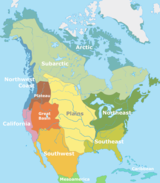Indigenous peoples of the Subarctic

Indigenous peoples of the Subarctic are the aboriginal peoples who live in the
Northwestern Russia and Siberia.[1] Peoples of subarctic Siberia and Greenland are included in the subarctic; however, Greenlandic Inuit are usually classified as Indigenous peoples of the Arctic
.
Languages
Native subarctic peoples have over 38 languages into five major language families:
.Arts and cultures
The
porcupine quill embroidery are also worked onto hides and birchbark. After introduction by Europeans and Asians, glass beads became popular and are sewn into floral designs.[1] Additionally, some cultures practiced agriculture, alongside hunting and gathering.[citation needed
]
In the
Sami culture of Scandinavia, reindeer husbandry has traditionally played an important role. Traditionally the Sami lived and worked in reindeer herding groups called siiddat, which consisted of several families and their herds. Members of the siidda helped each other with the management and husbandry of the herds.[3]
In
Nenets people, who practice nomadic herding, migrating long distances each year (up to 1,000 km annually) between their summer and winter pastures.[4]
At present about 13,500 Nenets are engaged with reindeer herding.
List of peoples
This section needs additional citations for verification. (January 2024) |
- Na-Dene
- Athabaskan–Eyak
- Athabaskan
- Northern Athabaskan
- Ahtna
- Sahtu
- Central Cordillera
- Chipewyan
- Dakelh
- Deg Hitʼan
- Denaʼina
- Babine
- Wet'suwet'en
- Dunneza
- Gwich'in
- Hän
- Hare
- Holikachuk
- Koyukon
- Sekani
- Slavey
- Tanana
- Tlicho
- Tsilhqot'in
- Northern Tutchone
- Southern Tutchone
- Upper Kuskokwim
- Yellowknives
- Northern Athabaskan
- Athabaskan
- Tlingit, United States (Alaska) and Canada (British Columbia and Yukon)
- Athabaskan–Eyak
- Algic
- Turkic
- Kipchak
- Kipchak–Bulgar
- Bashkir, Russia (Bashkortostan)
- Tatars
- Volga Tatars, Russia (Tatarstan)
- Kipchak–Bulgar
- Oghur
- Siberian Turkic
- Northern Turkic
- Dolgans
- Yakuts, Russia (Sakha Republic)
- Northern Turkic
- Kipchak
- Uralic
- Baltic Finnic
- Izhorians, Russia
- Karelian, Finland (South Karelia and North Karelia) and Russia (Republic of Karelia and Leningrad Oblast)
- Veps, Russia
- Votes, Russia
- Permian
- Komi, Russia (Komi Republic and Perm Krai)
- Udmurt, Russia (Udmurtia)
- Sámi
- Ugrians
- Khanty, Russia (Khanty-Mansi Autonomous Okrug)
- Mansi, Russia (Khanty-Mansi Autonomous Okrug)
- Volga Finnic
- Baltic Finnic
- Indo-European
- Germanic
- North Germanic
- Faroe Islanders, Faroe Islands
- North Germanic
- Slavic
- East Slavic
- Russians, Russia
- East Slavic
- Germanic
- Inuit
- Nunatsiavut, Canada (Labrador)
- NunatuKavut, Canada (Labrador)
See also

- Aboriginal peoples in Canada
- Alaska Natives
- Caribou
- Circumpolar peoples
- Hudson's Bay Company
- Subarctic climate
- Alaska Native Storytelling
- Sápmi
- Sakha
Notes
- ^ a b c d e f g h History of Indigenous Art in Canada Archived 2011-05-23 at the Wayback Machine The Canadian Encyclopedia. (retrieved 29 Dec 2010)
- ^ a b Corbett, Steve. "Native Peoples of the Subarctic." Archived 2011-05-29 at the Wayback Machine Johnson County Community College. (retrieved 21 Nov 2010)
- ^ "Sámi - Norway". Reindeerherding.org. Retrieved 12 March 2019.
- ^ "Nenets". Reindeerherding.org. Retrieved 12 March 2019.

